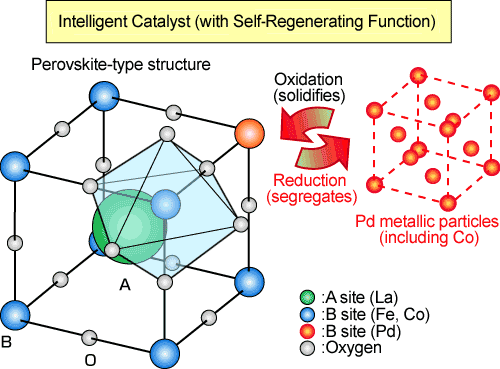- Products / Technology
- Technology
- SDGs /CSR /Environment
- NEWJul. 11, 2002
World-Leading Development of a Self-Regenerating "Intelligent Catalyst"
Jul. 11, 2002
Daihatsu has led the world in developing an "intelligent catalyst" for automotive emissions control that regenerates its precious metals in reaction to natural fluctuation of automotive exhaust gas, allowing it to suppress degradation and maintain fresh catalytic activity. The new catalyst presents high performance while dramatically reducing the large amount of precious metals, thus conserving a valuable natural resource and lowering the cost of the catalyst.
Daihatsu is now working to commercialize the new product as a next-generation, high-performance, low-cost automotive catalyst, following its successful introduction of the TOPAZ catalyst last year.
All the conventional automotive catalysts disperse fine particles of a precious metals such as palladium, platinum or rhodium, onto the surface of alumina or another supporting materials. To achieve a long-term catalytic durability, the conventional catalyst employs the excess amount of precious metals.
The amount of precious metals used in catalyst production has increased since the early 1990's, when automotive emissions standards were strengthened in all over the world. The use of palladium, however, which is able to effectively oxidize the hydro-carbons at relatively low temperatures, has seen particularly rapid growth. Because palladium is also widely used in other fields, including dentistry, and electrochemistry, it is important to reduce the use in the automotive catalyst.
A state-of-the-art automotive petrol engine is operated close to the theoretical air-to-fuel ratio by using oxygen sensors and a sophisticated feedback control system linked to the catalyst, a natural fluctuation associated with adjusting the air-to-fuel ratio occurs between excessive and insufficient oxygen states (called "oxidative" and "reductive" atmospheres, respectively). And the catalyst is constantly subjected to temperatures of 800°C or higher.
Heat exposure causes the fine particles of precious metals to agglomerate together in a phenomenon known as "particle growth," thus reducing the catalyst's overall surface area and its catalytic activity.
Palladium is also the most heat sensitive of the commonly applied precious metals. It has been difficult, by conventional technologies, to reduce the amount of palladium in the automotive catalyst.
Daihatsu has developed a nono-technology that uniformly layouts palladium ions, at the atomic level, into a special perovskite-type crystal. This allows the palladium to move into the perovskite crystal structure as metallic ions in the high-temperature oxidative atmosphere, then to segregate out of the crystal in the reductive atmosphere to form fine metallic particles. When the atmosphere again becomes oxidative, the palladium moves back into the crystal and repeats the cycle, effectively regenerating itself through a new function, without any auxiliary treatment, that suppresses particle growth.
The new technology greatly improves the heat resistance of palladium and boosts its catalytic activity and durability compared with conventional catalysts. Further, it can also be used with other precious metals, such as platinum and rhodium, to dramatically reduce the amounts of these vital natural resources required in catalyst production and lower catalyst costs accordingly.
In developing the new material, the Daihatsu team was aided by the co-operation of Professor Dr. Makoto Misono of Kogakuin University and Professor Dr. Noritaka Mizuno of The University of Tokyo. Analysis of the self-regenerating function was conducted jointly by Daihatsu, the Japan Atomic Energy Research Institute, Toyota Central R&D Labs., Inc., and Tokyo University of Science and was reported in the July 11th edition of the prominent scientific journal "Nature" in the United Kingdom as a new design concept for catalytic development.
(Complete document appears in Nature, Vol. 148 (2002) pp 164-167),
Terminology
TOPAZ catalyst: A high-performance, compact, long-life catalyst for purifying exhaust emissions developed by original Daihatsu technology and incorporated in Daihatsu mini cars since October 2001.
This industry-leading catalytic converter, called a "manifold converter" because it is placed closer to the engine, is able to achieve Japan's lowest level of exhaust emission (ULEV: ultra-low emission vehicle) with a single catalytic converter.
TOPAZ stands for "TOP from A to Z" and refers to a power unit that aims for top performance in all aspects, including power, ecology and reliability
Perovskite-type crystal: A ceramic crystal structure known for its high-temperature superconducting property.
Nature: One of the world's leading scientific journals, founded in the United Kingdom in 1869 to publish reports in the field of natural science in order to disclose important discoveries in scientific research. Breakthrough discoveries first reported in Nature have included the mapping of the human genome, discovery of the electron, and uranium decay. Circulation: 60,000/week.
Intelligent: An "intelligent material" is one that is able to sense changes in the environment in which it is used and change its structure and functions accordingly to optimize its performance. (This definition is from the "Intelligent Materials Forum" of May 1990.)
Daihatsu named its newly developed catalyst an "intelligent catalyst" because of its ability to regenerate itself at the nano-meter level.
Nano-technology: Japan's 2nd Scientific Technology Basic Plan, which was determined by a Cabinet council on 31 March 2001, lists nano-technology as an important strategic technology. The development of materials that are capable of regenerating themselves at the nano-meter level is a project item within the Basic Plan.
[Reference information]





